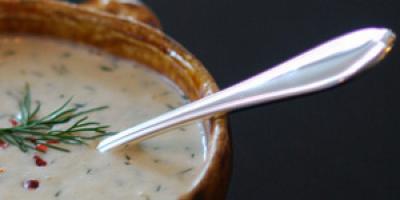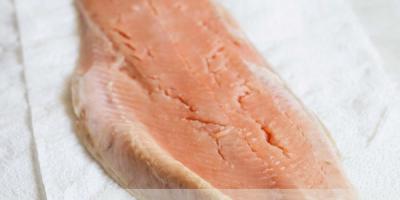This article presents 5 basic French sauces. Basic, ancestral. By adding one or another ingredient to the base, you can get countless sauces.
All French sauces (and there are more than 3000 types, which is no wonder, because parsley in mayonnaise is one sauce, and dill is a completely different one, the French are cunning) are divided into 5 main families, according to the classification Auguste Escoffier– bechamel, veloute, hispanol, tomato and hollandaise sauces.
By adding various additives to these basic sauces, changing the consistency, adding ingredients familiar to a certain area, thousands of different names are obtained. But the basis remains the same! I, as a very simple person, see this as a kind of trick, because... Since I add pickles and capers to mayonnaise, I get mayonnaise sauce with cucumbers and capers. The French have their own name - Tatar.
Bechamel
Bechamel It was first mentioned in the famous treatise by the famous chef François La Varenne, “The French Cuisine” (“Le Cuisinier François”), which was published in 1651. It is believed that this sauce was named after the Marquis Louis de Bechamel, a rich and influential nobleman who, however, had nothing to do with cooking. According to Escoffier's classic recipe, milk and a little salt are added to a lightly fried mixture of white flour and butter (in French cuisine this mixture is called roux). These days, bechamel is often used to make lasagne and is also served with pasta.
Veloute or Veloute (Veloutẻ)  A distant "relative" of bechamel veloute(or “white sauce”) also boasts a respectable age - the first mention of it dates back to 1553. This is a sauce based on a light broth (from chicken, veal or even fish), which is thickened with a mixture of white flour and fat - usually butter (in fact, this is the roux that appears in the bechamel recipe). In American cuisine, bacon fat is sometimes used instead of butter. All this is seasoned with salt and pepper. Veloute (or sauces based on it) is usually served with poultry and seafood.
A distant "relative" of bechamel veloute(or “white sauce”) also boasts a respectable age - the first mention of it dates back to 1553. This is a sauce based on a light broth (from chicken, veal or even fish), which is thickened with a mixture of white flour and fat - usually butter (in fact, this is the roux that appears in the bechamel recipe). In American cuisine, bacon fat is sometimes used instead of butter. All this is seasoned with salt and pepper. Veloute (or sauces based on it) is usually served with poultry and seafood.
Espanol (Espagnole)  Spanish sauce- This is the main "brown" sauce of French cuisine. According to legend, a certain Spanish chef, who came to the wedding of Louis XIII with Anne of Austria, had a hand in its creation (remember the film “The Three Musketeers” - “Am I Spanish or not?!”). Its basis is the same mixture of flour and butter, however, fried until dark brown. The mixture is added to a strong veal broth, along with bones, pieces of beef, vegetables and seasonings. All this is simmered for a long time over low heat so that the sauce thickens and its volume decreases significantly. At the end, tomato sauce is added (this is what the Spanish chef allegedly proposed). Español is usually prepared in large quantities and then frozen for use when needed. As a rule, it is not used in its pure form, but in combination with other components (especially spices).
Spanish sauce- This is the main "brown" sauce of French cuisine. According to legend, a certain Spanish chef, who came to the wedding of Louis XIII with Anne of Austria, had a hand in its creation (remember the film “The Three Musketeers” - “Am I Spanish or not?!”). Its basis is the same mixture of flour and butter, however, fried until dark brown. The mixture is added to a strong veal broth, along with bones, pieces of beef, vegetables and seasonings. All this is simmered for a long time over low heat so that the sauce thickens and its volume decreases significantly. At the end, tomato sauce is added (this is what the Spanish chef allegedly proposed). Español is usually prepared in large quantities and then frozen for use when needed. As a rule, it is not used in its pure form, but in combination with other components (especially spices).
Tomato sauce Variations of this well-known family of sauces are usually served with pasta, meat dishes and vegetables. Europeans adopted tomato sauce from the Aztecs when they realized that tomatoes, despite their suspiciously bright colors, were not at all poisonous. The simplest tomato sauce is prepared as follows: chopped tomatoes are cooked over low heat in a frying pan with olive oil. Onions and garlic are often pre-fried. Basil, parsley, oregano and other herbs are added to the sauce. There are variations of tomato sauce with garlic, olives, chili peppers, anchovies and so on.
Variations of this well-known family of sauces are usually served with pasta, meat dishes and vegetables. Europeans adopted tomato sauce from the Aztecs when they realized that tomatoes, despite their suspiciously bright colors, were not at all poisonous. The simplest tomato sauce is prepared as follows: chopped tomatoes are cooked over low heat in a frying pan with olive oil. Onions and garlic are often pre-fried. Basil, parsley, oregano and other herbs are added to the sauce. There are variations of tomato sauce with garlic, olives, chili peppers, anchovies and so on.
Hollandaise sauce  Hollandaise sauce- this, in physical terms, is an emulsion of egg yolks and melted butter. Its modern recipe dates back to the 19th century. The butter is filtered through a strainer and gradually added to the thoroughly beaten yolks. In this case, it is recommended to keep the sauce over boiling water (what is called a water bath). Typically, the sauce is seasoned with lemon juice, salt and black, white or cayenne pepper (there are also options with grated nutmeg). This smooth, creamy sauce is served with fish, seafood, vegetables, and eggs.
Hollandaise sauce- this, in physical terms, is an emulsion of egg yolks and melted butter. Its modern recipe dates back to the 19th century. The butter is filtered through a strainer and gradually added to the thoroughly beaten yolks. In this case, it is recommended to keep the sauce over boiling water (what is called a water bath). Typically, the sauce is seasoned with lemon juice, salt and black, white or cayenne pepper (there are also options with grated nutmeg). This smooth, creamy sauce is served with fish, seafood, vegetables, and eggs.
Follow the classics and creating your own based on proven sauces is a real pleasure. Provided that this sauce can be taken into the mouth, of course.
:) If this article was useful to you, click "I like", so you will express your gratitude to the author. (author of the article: Artur Protchenko
How much does brown espagnole sauce cost (average price per package)?
Moscow and Moscow region.
Brown espagnole sauce is considered one of the four main or base sauces of French cuisine. Along with sauces, allemande and sauce in Spanish or la sauce espagnole have taken their rightful place in the ancient culinary tradition of France. The main highlight of brown espagnole sauce lies in the original composition of the ingredients and the method of making the product. Like other base sauces, espagnole is made from roux, i.e. wheat flour and fat fried in butter.
Since the Middle Ages, France has used roux as a thickener for basic sauces. There are several types of flour base for sauces:
- roux blanc or white roux;
- roux blond or golden roux is made like the white variety, but is fried longer to give the flour its distinctive golden color;
- roux brun or red roux, to achieve a dark color, add meat juice to the sauce base;
Brown espagnole sauce is made using dark roux and meat stock. In addition, pre-sautéed vegetables and herbs are added to the brown espagnole sauce. In order to make the taste of the sauce more piquant, tomatoes in their own juice or tomato paste are added to the Espanol. Legend has it that the famous brown espagnole sauce was invented by one of the court chefs who was hired to host a ball in honor of the wedding of Anne of Austria and Louis XIII. The cook was Spanish and decided to change the classic French white sauce in his own way.
The cook fried the flour base for the sauce longer than usual, so the roux turned light brown. The cook mixed wheat flour fried until golden brown with rich veal broth. The finishing touch to the new masterpiece of world cooking called brown espagnole sauce is tender pieces of beef, vegetables, herbs and tomatoes. Gourmets claim that tomatoes give the distinctive taste and aroma of Espanole sauce. It is noteworthy that French housewives prepare Espanol sauce for future use. Brown sauce was incredibly popular until the 17th century.
Then new varieties of sauces replaced Espanol. At the beginning of the 19th century, chefs Auguste Escoffier and Antoine Carême decided to revive the former greatness of espagnole sauce. Nowadays, French meat dishes are served with classic brown espagnole sauce. It is believed that Español sauce goes perfectly with pork, beef and lamb dishes. In addition, bacon or ham and meat fried over an open fire are seasoned with brown sauce. The Italians have adopted the French sauce and use espagnole in their famous ravioli.
Calories in brown espagnole sauce: 97.5 kcal
Energy value of brown espagnole sauce (Ratio of proteins, fats, carbohydrates - bju):
: 0.7 g (~3 kcal)
: 9.1 g (~82 kcal)
Meat broth (pork or beef) - 1 liter
Flour - 50 grams
Butter - 50 grams
Vegetable oil - 20 grams
Tomato paste or ketchup without additives - 30 grams
Carrots - 3 pieces
Onions - 3 heads
Greens of your choice - to taste
How to cook espagnole sauce
1. Prepare the base of the sauce - melt the butter in a frying pan with a thick bottom, add flour.
2. Stirring constantly, fry the mixture for 2 minutes until it begins to darken.
3. Dilute tomato paste (ketchup) in the broth and pour into the mixture.
4. Pour in the broth carefully, in portions, so as not to splash.
5. Bring the future sauce to boil (in the same frying pan or saucepan) over low heat.
6. Wash and peel the carrots and onions. Finely chop the onion and grate the carrots on a coarse grater.
7. Sauté vegetables in vegetable oil until soft, ready to add to the sauce.
8. Cook the espagnol for 4 hours over low heat, removing the foam and droplets of fat from time to time.







